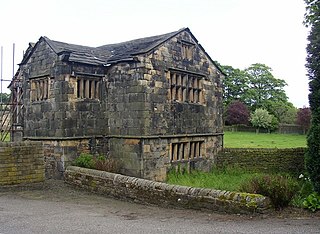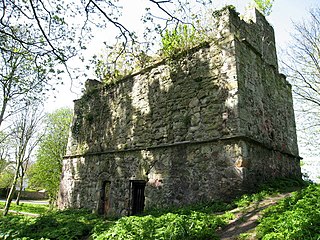Related Research Articles
Aby with Greenfield is a civil parish in the East Lindsey district of Lincolnshire, England. The population of the civil parish at the 2011 Census was 196. It consists of the villages of Aby and Greenfield. The parish is situated approximately 7 miles (11 km) south-east from Louth.

Arthington Priory was an English monastery which was home to a community of nuns in Arthington, West Yorkshire, founded in the mid-12th century. The priory land is occupied by a residence called "Arthington Hall", which was built around 1585, and little, if anything, remains of the priory. The site of the priory church is possibly now occupied by a farmhouse called The Nunnery. The community was the only one of nuns of the Cluniac congregation in Yorkshire and one of two in England. It was established through a grant by Peter de Arthington.
Stanlow Abbey was a Cistercian abbey situated on Stanlow Point, on the banks of the River Mersey in the Wirral Peninsula, Cheshire, England, near today's Ellesmere Port, 11 km north of Chester Castle and 12 km south-west of Halton Castle.

Swine Priory was a priory in the village of Swine in the East Riding of Yorkshire, England. The site of the Cistercian nunnery is a Scheduled Monument.
Cammeringham Priory was a priory in Cammeringham, Lincolnshire, England.
Gokewell Priory was a Cistercian Catholic priory in Broughton, Lincolnshire, England..
Heynings Priory was a priory in Knaith, Lincolnshire, England.

Kyme Priory was a priory in South Kyme, Lincolnshire, England. What remains of the buildings are now part of Saint Mary and All Saints Church.
Legbourne Priory was a priory in the village of Legbourne, Lincolnshire, England.

Nuncotham Priory was a priory of Cistercian nuns in Brocklesby, Lincolnshire, England.
Stixwould Priory was a priory in Lincolnshire, England, a Cistercian nunnery founded by Lucy, countess of Chester, in 1135. The Mappa Mundi describes it as Gilbertine, but modern authors regard it as Premonstratensian. Originally suppressed in 1536, Benedictine nuns from Stainfield were then moved in by the King. In 1537 the nunnery was refounded for Premonstratensian canonesses, before being finally suppressed in 1539.

Louth Park Abbey was a Cistercian abbey in Lincolnshire, England. It was founded in 1139 by the Bishop Alexander of Lincoln as a daughter-house of Fountains Abbey, Yorkshire.
Sele Priory was a medieval monastic house in Upper Beeding, West Sussex, England.

Esholt Priory was a Cistercian priory in West Yorkshire, England. Esholt Hall now stands on the site of the priory.

Kirklees Priory was a Cistercian nunnery whose site is in the present-day Kirklees Park, Clifton near Brighouse, West Yorkshire, England. It was originally in the ancient ecclesiastical parish of Dewsbury. The priory dedicated to the Virgin Mary and St James was founded by Reiner le Fleming, Lord of the manor of Wath upon Dearne, in 1155 during the reign of Henry II.

St. Mary's Priory, North Berwick, was a monastery of nuns in medieval East Lothian, Scotland. Founded by Donnchad I, Earl of Fife around 1150, the priory lasted for more than four centuries, declining and disappearing after the Scottish Reformation. It had been endowed by the Earls of Carrick as well as the Earls of Fife, but over time lost its dependence on these and came to be controlled by the more locally based Home family, who eventually acquired the priory's lands as a free barony.
Elcho Priory was a medieval Cistercian Priory in Perthshire, Scotland, dedicated to the Virgin Mary.
The former Priory of Douglas was a Cistercian monastery of nuns on the Isle of Man, apparently founded in the reign of Rǫgnvaldr Guðrøðarson, King of the Isles.

The Keldholme Priory election dispute occurred in Yorkshire, England, in 1308. After a series of resignations by its prioresses, the establishment was in a state of turmoil, and the Archbishop of York, William Greenfield, appointed one of the nuns to lead the house. His candidate, Emma de Ebor', was deemed unacceptable by many nuns, who undermined her from the start to the extent that she resigned three months later. The archbishop, forced to find another candidate, claimed that he was unable to do so from within the priory and appointed Joan de Pykering from nearby Rosedale Priory. It is likely that Keldholme saw de Pykering as an intruder, and it seems to have reacted against her in much the same way as to her predecessor.

The Littlemore Priory scandals took place between 1517 and 1518. They involved accusations of sexual immorality and sometimes brutal violence among the Benedictine nuns and their prioress at St Nicholas' Priory in Littlemore, in Oxfordshire, England. The priory was very small and poor, and had a history of troubled relations with its bishops, dating back to the mid-1400s. The scandal that came to light in 1517, however, became enough of a cause célèbre to contribute to the priory's eventual suppression in 1525. Katherine Wells, the prioress of Littlemore at that time, ran the priory with strict and often violent discipline. She was accused of regularly putting nuns in the stocks for extended periods, as well as physically assaulting them. She also had a baby by the priory's chaplain and had pawned the priory's jewels to pay for the child's upbringing. She entertained men in her parlour, even after the bishop had been made aware of the accusations, which involved heavy drinking. At least one other nun also had a child. On one occasion a number of the nuns broke out of the priory through a window and escaped into the surrounding villages for some weeks.
References
- ↑ "The Priory of Greenfield". Houses of Cistercian Nuns. Victoria County History. Retrieved 3 August 2011.
Coordinates: 53°16′45″N0°08′49″E / 53.279180°N 0.147045°E
| This article about a Lincolnshire building or structure is a stub. You can help Wikipedia by expanding it. |
| | This article about a British Christian monastery, abbey, priory or other religious house is a stub. You can help Wikipedia by expanding it. |

